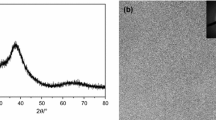Abstract
The normal interpretation of kinetic parameters in thermal analysis (DTA, TG) are deduced from isothermal experiments. In the present work, we propose a method which takes into account non-isothermal conditions, particularly high heating rates are considered. The new basic equation for the reaction rate includes in the Arrhenius relation the number of nuclei per unit volume in the sample at temperatureT. This number is a function of the heating ratev. This model allows, in particular, to account for the curvature of the variation of ln (v/T 2c ) as a function of the inverse of the crystallization peak temperature (1/Tc) for high heating rates in DTA experiments. This model is applied successfully to DTA results on an amorphous CdGeAs2 compound.
Résumé
Les interprétations classiques des paramètres cinétiques en analyse thermique (ATD, TG) sont généralement déduites d'expériences réalisées en régime isotherme. Dans le présent travail, nous proposons une méthode qui prend en considération des conditions non isothermes et, en particulier, des vitesses de montée en température élevées. La nouvelle équation de base donnant la vitesse de réaction, introduit dans la relation d'Arrhenius le nombre de germes par unité de volume dans l'échantillon à la températureT, ce nombre étant une fonction de la vitesse de montée en températureν. Ce modèle permet de rendre compte, en particulier, de la courbure de Ln (ν/sT 2c ) en fonction de l'inverse (1/Tc) de la température du pic de cristallisation pour les grandes vitesses en ATD. Ce modèle est appliqué de façon satisfaisante aux résultats ATD obtenus sur le composé amorphe CdGeAs2.
Zusammenfassung
Die klassischen Deutungen der kinetischen Parameter der Thermoanalyse (DTA, TG) werden im Allgemeinen aus isotherm geführten Versuchen abgeleitet. In der vorliegenden Arbeit wird eine Methode vorgeschlagen, welche nicht-isotherme Bedingungen und besonders hohe Temperaturanstiegsgeschwindigkeiten berücksichtigt. Die neue Grundgleichung zur Angabe der Reaktionsgeschwindigkeit führt in die Arrheniussche Funktion die Keimzahl je Volumeinheit in der Probe bei der TemperaturT ein, wobei diese Zahl eine Funktion der Geschwindigkeitν des Temperaturanstieges ist. Dieses Modell gestattet besonders die Deutung der Krümmung von ln (ν/T 2c ) als Funktion des Reziprokwertes(1/T c) der Temperatur des kristallisationspeaks bei hohen Aufheizgeschwindigkeiten in DTA-Untersuchungen. Dieses Modell konnte bei den DTA-Ergebnissen der amorphen Verbindung CdGeAs2 mit befriedigendem Ergebnis eingesetzt werden.
Резюме
Обычная интерпретац ия кинетических параметров в термиче ском анализе (ДТА, ТГ) выводится из из отермических экспер иментов. В настоящей работе пре дложен метод, в котором учиты ваются неизотермиче ские условия и, в особеннос ти, высокие скорости нагрева. Нов ое основное уравнени е для скорости реакции вкл ючает в уравнение Арренийса число ядер на единицу объема в ве ществе при температуреТ. Это чи сло является функцией скорости на греваv. В особенности, эта модель позволяет представи ть кривизну изменения ln (v/T 2 c ) как функ цию обратного кристаллизационног о пика температуры (1/T c) для высоких скорос тей нагрева в ДТА экспериментах. Модел ь успешно была примен ена в ДТА исследовании ам орфного CdGeAs2.
Similar content being viewed by others
Bibliographie
T. Ozawa, J. Thermal Anal. 2 (1970) 301.
H. E.Kissinger, J. Res. Nat. Bur. Std., 57 (1956) n∘ 4.
D. Fatu, J. Thermal Anal., 1 1969 285.
M. D.Baro, S.Bordas, N.Clavaguera et M. T.Clavaguera-Mora, Journées de Calorimétrie et d'Analyse Thermique Paris-Orsay, CESI, pt F, 12–13 mai 1977, AFCAT.
A. Fevre, M. Murat etC. Comel, J. Thermal Anal., 12 (1977) 429.
P. Barret, J. Chim. Phys., 70 (1973) 225.
A.Souchon, Thèse présentée à l'Institut National Polytechnique de Grenoble, Avril 1977.
P.Barret, Cinétique hétérogène, Gauthier-Villars Ed., p. 258, 1973.
J.Burke, La cinétique des changements de phase dans les métaux, Trad. M. MORAL, Masson et Cie Editeurs, p. 23, 1968.
H. J. Borchardt etF. Daniels, J. Am. Chem. Soc., 79 (1957) 41.
S. Risbud, J. Amer. Ceram. Soc., 57 (1974) 272.
U. Koster, Phys. Status Solidi, A 48 (1978) 313.
Author information
Authors and Affiliations
Rights and permissions
About this article
Cite this article
Danh, T.H., Defresne, A. & Soustelle, M. Modèle de cinétique de cristallisation en régime dynamique dans les solides amorphes. Journal of Thermal Analysis 18, 169–183 (1980). https://doi.org/10.1007/BF01909465
Received:
Revised:
Issue Date:
DOI: https://doi.org/10.1007/BF01909465



